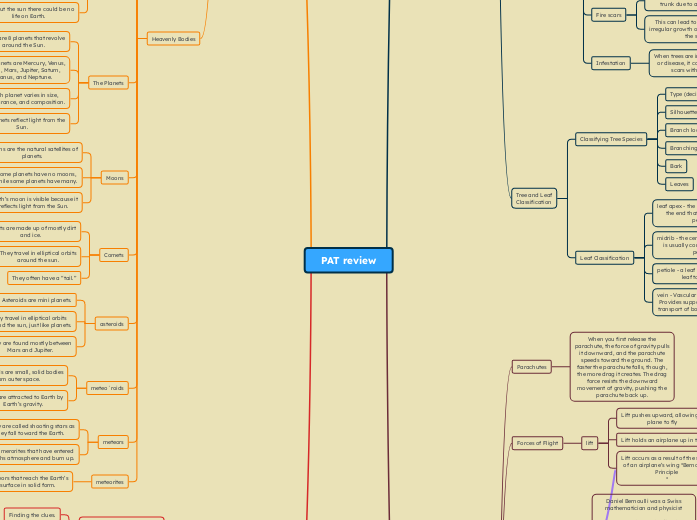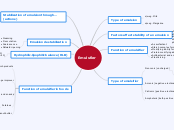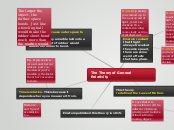PAT review
crime and investigation
Fabric Analysis
Texture
Reaction to heat
Color
Absorbency
Stretchability
Handwriting Analysis
Content – Spelling, punctuation,
and grammar
Arrangement – The spacing of the
letters across
the page
Lines – thickness of the lines made
by the pen or
pencil
Form – the slant, shape, and curves
of the letters
Chromatography
chromatography is a method that is
used to
separate colored chemicals or
substances, such as
the ink in pens.
Fingerprints
Everyone has their own unique
fingerprint.
Footprints
Height
A person’s height can be estimated
by using the
size of the footprint.
Weight
Scientists use weights on the same
ground to
estimate weight of person.
The deeper the footprint, the
heavier the person
was.
Speed
The wide the space, the faster the
person was
moving.
Short spaced footprints show a
slow walk
E.g. Speed, Direction, Weight,
Height, Where the
person has been
Footprints can tell you a lot of
information about
an individual.
Observation Skills
Looking for Signs/Clues
Every activity leaves behind a trail
of clues or
signs of what happened.
To find clues, one must learn to
observe
correctly.
Observation: the action or process
of
observing something or someone
carefully in
order to gain information.
There are 2 problems when it
comes to Evidence
Determining what the clues mean
or
DEDUCING (Deduction)
Finding the clues.
sky science
Heavenly Bodies
meteorites
Meteors that reach the Earth’s
surface in solid form.
meteors
Are merorites that have entered
earths atmosphere and burn up.
`They are called shooting stars as
they fall toward the Earth.
meteo`roids
They are attracted to Earth by
Earth’s gravity.
`Meteoroids are small, solid bodies
from outer space.
asteroids
They are found mostly between
Mars and Jupiter.
They travel in elliptical orbits
around the sun, just like planets.
Asteroids are mini planets.
Comets
They often have a “tail.”
They travel in elliptical orbits
around the sun.
Comets are made up of mostly dirt
and ice.
Moons
Earth’s moon is visible because it
reflects light from the Sun.
Some planets have no moons,
while some planets have many.
Moons are the natural satellites of
planets.
The Planets
The planets reflect light from the
Sun.
Each planet varies in size,
appearance, and composition.
The planets are Mercury, Venus,
Earth, Mars, Jupiter, Saturn,
Uranus, and Neptune.
There are 8 planets that revolve
around the Sun.
The Sun
Without the sun there could be no
life on Earth.
The sun emits light and gives off
heat.
The word solar means sun.
The Sun is the star that is at the
center of our solar system.
constellations
The Big Dipper (Ursa Major), and
Orion are all constellations.
There are 88 constellations in the
sky.
A constellation is a group of stars
that appears to form a pattern in
the sky.
galaxies
Approximately 200 million stars are
in the Milky Way. The Sun is one of
them.
Our galaxy is called The Milky Way.
A galaxy is a cluster of stars.
The closest star to the Earth is the
Sun.
They emit light through nuclear
fusion, which happens deep inside
the star.
They come in all shapes, sizes,
colours, compositions, and
temperatures.
Stars are the heat and light sources
of the universe.
satellites
Humans have launched man-made
satellites so that they orbit the
Earth.
The planets are natural satellites of
the Sun.
The moon is a natural satellite for
the planet Earth.
A satellite is the name for any
heavenly body that revolves
around another.
galaxys an stars and plants
reflect
planets
give back or bounce
emit
stars
give off
Solar System
There are eight planets that make
up our solar system
Neptune
Uranus
Jupiter
Mars
Earth
Venus
Mercury
Galaxy
You can see the andromeda galaxy
in the sky
The closest galaxy to earth is the
Andromeda Galaxy which is 2
million light years away
The Milky way galaxy contains 200
billion stars
Earth is a part of the milky way
galaxy
The Universe
Space is also filled with radiation
(e.g. light and heat), magnetic
fields and high energy particles
(e.g. cosmic rays).
The space between the stars and
galaxies is largely empty but
contains some scattered particles
of dust or a few hydrogen atoms
per cubic centimeter.
Contains billions of galaxies, each
containing millions or billions of
stars.
Properties of Air
Airplanes & Controlling
FlightAirplanes & Controlling Flight
Rudders: Yaw
The rudder is located on the tail of
the aircraft. It works identically to a
rudder on a boat, steering the nose
of the aircraft left and right. Unlike
the boat however, it is not the
primary method of steering. Its
main purpose is to counteract the
drag caused by the lowered aileron
during a turn. This adverse yaw, as
it is known, causes the nose of the
airplane to point away, or
outwards, from the direction of the
turn. The rudder helps to correct
this by pushing the nose in the
correct direction, maintaining what
is known as coordinated flight
Ailerons: Roll
The ailerons are located at the rear
of the wing, one on each side.
They work opposite to each other,
so when one is raised, the other is
lowered. Their job is to increase
the lift on one wing, while reducing
the lift on the other. By doing this,
they roll the aircraft sideways,
which allows the aircraft to turn.
This is the primary method of
steering a fixed-wing aircraft.
Elevators: Pitch
As the name implies, the elevator
helps “elevate” the aircraft. It is
usually located on the tail of the
aircraft and serves two purposes.
The first is to provide stability by
producing a downward force on
the tail. Airplanes are traditionally
nose-heavy and this downward
force is required to compensate for
that. The second is to direct the
nose of the aircraft either upwards
or downwards, known as pitch, in
order to make the airplane climb
and descend.
Rudder/Vertical and Horizontal
Stabilizers
When the elevator is lowered, the
nose drops
When angled up, the nose of the
plane rises
The elevator can be controlled in
an up and down motion
The horizontal stabilizer prevents
an up-and-down motion of the
nose, which is called pitch.
The vertical stabilizer keeps the
nose of the plane from swinging
from side to side, which is called
yaw. Motion can be controlled by
the rudder.
The stabilizers’ job is to provide
stability for the aircraft, to keep it
flying straight.
To control and maneuver the
aircraft, smaller wings are located
at the tail of the plane.
Aileron
Ex. If the left aileron is lowered and
the right aileron is raised, the plane
will roll to the right
If they are angled in opposite
directions, the plane will roll in the
direction of the raised aileron
Ailerons are small surfaces on the
ends of the wings
Slats/Spoiler (located on wings)
Slats are used at takeoff and
landing to produce additional
force. The spoilers are also used
during landing to slow the plane
down and to counteract the flaps
when the aircraft is on the ground.
Flaps are deployed downward on
takeoff and landing to increase the
amount of force produced by the
wing. On some aircraft, the front
part of the wing will also deflect.
Turbines/Jet Engines & Propellers
Smaller, low-speed airplanes use
propellers for the propulsion
system instead of turbine engines.
The turbine engines, which are
located beneath the wings, provide
the thrust to overcome drag and
push the airplane forward through
the air.
Wings/Airfoil
Modern airliners use winglets on
the tips of the wings to reduce
drag.
The wings generate most of the lift
to hold the plane in the air.
To generate lift, the airplane must
be pushed through the air. The air
resists the motion in the form of
aerodynamic drag.
Cockpit
It has all the controls to fly the
plane
The front part of the aircraft where
the pilots fly the plane from
Fuselage
It can be used to carry passengers
and cargo
It is a long, hollow tube that holds
all of the pieces of an airplane
together
The fuselage is the main body of
the airplane
5 Propertys
Property 5: Air is Affected by
Temperature
The colder the air becomes, the
slower the air particles move
(lowering pressure)
The greater the temperature, the
faster the air particles move
(increasing pressure)
Property 4: Air can be Compressed
Air particles can be compressed
and squished together to take up
less space.
Property 3: Air Exerts Pressure
Air exerts pressure (in all
directions). The air above the
paper pushes down on it
(pressure). This pressure is what
makes the paper lay flat on the
table - it's being pushed down.
Even though they're too tiny to
see, all the molecules of air in the
atmosphere above your head
weigh something.
Property 2: Air Has Mass
Every square inch of surface on the
earth has about 15 pounds of air
sitting on it. Air is piled about 100
miles high on each square inch.
Air is really quite heavy and has
mass. You don’t notice it because
your body is adapted withstand the
air pressure that you experience
every day.
Property 1: Air Takes Up Space
Air is a mixture of gasses that take
up space in the world around you.
Although you may not see it or
think because it has always been
there, air takes up the space
around us.
WHAT ADAPTATIONS DO
INSECTS have to help them FLY
Insects don’t have bones - their
bodies are light
Strong muscles in the midsection
or thorax
Wings don’t just flap up and down,
they rotate
Wings are shaped like an airfoil,
just like birds and airplanes
Wings are very light structures
Most insects have two pairs of
wings
Bernoulli’s Principle
Faster air = low pressure
Slower air = high pressure
Bernoulli’s Principle: as air moves
around an object, it creates
different pressures on that object
Daniel Bernoulli was a Swiss
mathematician and physicist
He came from a family of
mathematicians
He helped create Bernoulli’s
Principle, which is very important in
Aerodynamics
Forces of Flight
lift
Lift occurs as a result of the shape
of an airplane’s wing *Bernoulli’s
Principle
*
Lift holds an airplane up in the sky
Lift pushes upward, allowing a
plane to fly
Parachutes
When you first release the
parachute, the force of gravity pulls
it downward, and the parachute
speeds toward the ground. The
faster the parachute falls, though,
the more drag it creates. The drag
force resists the downward
movement of gravity, pushing the
parachute back up.
trees and forests
Tree and Leaf
Classification
Leaf Classification
vein - Vascular structure on a leaf.
Provides support for the leaf and
transport of both water and food.
petiole - a leaf stalk; it attaches the
leaf to the plant.
midrib - the central rib of a leaf - it
is usually continuous with the
petiole.
leaf apex - the outer end of a leaf;
the end that is opposite the
petiole.
Classifying Tree Species
Leaves
Bark
Branching Patterns
Branch location
Silhouette
Type (deciduous vs coniferous)
Growing conditions
Infestation
When trees are infested by insects
or disease, it can leave holes or
scars within the tree.
Fire scars
This can lead to a fire scar and
irregular growth of the tree around
the scar.
Trees sometimes lose part of their
trunk due to a forest fire.
Competition, Pushing, and Slope
Sometimes you may notice a ring
with wider growth on one side and
narrower growth on the other.
Trees growing on an uneven slope
(hillside or uneven ground)
Trees pushing up against a building
Competition from other nearby
trees
Drought
You know a tree has gone through
a drought when some rings are
narrower than others
Tree rings can be narrower in
sections because the tree has not
had access to enough water which
slows its growth
Optimal Growing Conditions
You know the tree has had optimal
growing conditions if all tree rings
are the same size
Tree is able to grow effectively
without any interruptions in its
cycle due to environmental
conditions
What are the different parts of a
Tree
Item 6
Outer Bark
This layer protects a tree from
insects and disease, excessive heat
and cold, and other injuries.
Item 5
Heartwood
Heartwood develops as a tree gets
older. It is old sapwood that no
longer carries sap, and gives the
trunk support and stiffness. In many
kinds of trees, heartwood is a
darker color than sapwood, since
its water-carrying tubes get
clogged up. The tree cookie at
right, like many of its fellow young
pines, has not developed
heartwood yet.
Item 4
Growth Ring
The lighter portion is called the
"early wood" (beacuse it grows in
the spring), and the darker portion
the "late wood" (which grows in
the summer). Together, they
represent one year of growth.
Item 3
Xylem
Also called the sapwood. This layer
carries the sap (water plus nitrogen
and mineral nutrients) back up from
the roots to the leaves. Sapwood
gives a tree its strength.
Item 2
Phloem
Also called the inner bark. This
layer carries sugar made in the
leaves or needles down to the
branches trunks and roots, where it
is converted into the food the tree
needs for growth.
Item 1
Cambium
The layer or zone of cells, just one cell thick, inside the inner bark.
The cambium produces both the xylem and phloem cells. This is
where diameter growth occurs, and where rings and inner bark
are formed.
Tree Cookies
tree rings
Together these two types of wood
represent one year of growth
Late wood: dark colored and is the
growth that happens over fall and
winter
Early Wood: Light colored wood is
called early wood as it grows in
summer and spring
Every year a tree is alive is adds
new growth to its trunk that when
analyzed can help you to
understand more information
about the tree
Tree rings are like the growth chart
of a tree. Easily visible rings can
provide information about the
weather, soil, and light conditions
over time.
Dendrochronology
A dendrodisc (tree cookie) is a
cross sectional slice of a tree.
Dendrochronology is the scientific
study of growth patterns and the
aging of trees, as shown in their
rings.
Dendrochronology comes from the
roots dendro- meaning “tree” and
chronology meaning “the study of
time.”
what is a tree
A plant with supporting woody
branches and leaves
A plant with a long woody stem
known as a trunk
A perennial - this means a plant
with a continuous growth cycle
type of trees
Deciduous
From the Latin word decider – “fall
down or off”
Have existed for 60 – 100 million
years
Seeds are in vessels – fruit,
capsules, seeds, etc.
Do not withstand temperature
extremes
Are broad-leafed
Shed leaves in fall, grow leaves in
spring
known as “broadleaved trees” or
“hardwoods trees”
Coniferous
facts
From the Latin word conifer –
“cone-bearing”
Have existed for about 300 million
years
Seeds are well protected by a
sharp-toothed cone
Are good at withstanding
temperature extremes
Stay green all year round
Have needle shaped leaves
Shed and grow their leaves
continually.
known as “evergreens” or
“softwoods ”









